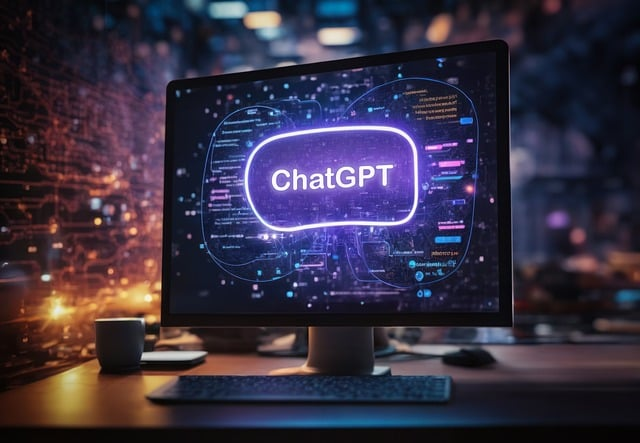
Artificial intelligence (AI) has become a cornerstone for innovation and efficiency in the ever-evolving digital landscape. Among its many applications, ChatGPT, a large language model developed by OpenAI, stands out as a precious tool.
This blog post aims to explore the best ChatGPT use cases, shedding light on how this AI technology can revolutionize various aspects of business and creativity.
ChatGPT Explained
ChatGPT is a state-of-the-art language model that utilizes advanced natural language processing (NLP) to generate human-like responses. It's part of the broad family of large language models transforming how we interact with data and technology.
ChatGPT excels in understanding and generating text as an AI tool, making it highly versatile for numerous tasks.
How Does ChatGPT Work?

At its core, ChatGPT analyses vast amounts of data to understand and replicate human language patterns. This process involves using artificial intelligence and large language models to interpret and respond to user inputs.
As a result, ChatGPT can generate remarkably human-like text, providing valuable assistance in various industries.
Best ChatGPT Use Cases
1. Content Creation
One of the prime use cases for ChatGPT is where it aids in generating various types of written content. It can significantly streamline the content development process, offering efficiency and creativity.
Examples of how ChatGPT assists in content creation include:
Blog Writing: ChatGPT can help draft blog posts on diverse topics, providing a starting point for writers or even creating entire posts.
Social Media Content: It can generate engaging social media posts for platforms like Facebook, Twitter, or Instagram, helping maintain a consistent and creative social media presence.
Marketing Copy: ChatGPT assists in crafting compelling marketing messages, advertisements, and promotional content that resonates with the target audience.
Email Campaigns: It can be used to write effective email content for marketing efforts or communication campaigns.
Creative Writing: Writers can use ChatGPT to generate story ideas, dialogues, and even poetry or short stories.
Product Descriptions: E-commerce sites can use it to create detailed and attractive product descriptions.
Scriptwriting: For video creators, ChatGPT can assist in writing scripts for YouTube videos, commercials, or other video content.
ChatGPT helps save time, generate ideas, and improve the quality of the content produced.
2. Customer Service
Refers to leveraging this AI technology to enhance and streamline interactions with customers. ChatGPT can handle various customer service tasks in this role, improving efficiency and response quality.
Examples include:
Automated Customer Responses: ChatGPT can instantly reply to customer inquiries, providing quick and accurate answers to common questions. It ensures that customers receive timely assistance, significantly improving their experience.
24/7 Support: Unlike human agents, ChatGPT can operate round the clock, offering continuous support to customers across different time zones, ensuring that help is always available.
Handling High Volume Queries: ChatGPT can manage many simultaneous inquiries during peak times, reducing wait times and preventing customer service bottlenecks.
Personalized Recommendations: ChatGPT can provide customized product or service recommendations by analyzing customer data and past interactions, enhancing the overall customer experience.
Multilingual Support: ChatGPT's multilingual capabilities make it an essential asset for international businesses, enabling them to cater effectively to a varied global customer audience.
Feedback Collection and Analysis: ChatGPT can solicit and analyze customer feedback, providing businesses with valuable insights into customer satisfaction and areas for improvement.
ChatGPT can be a valuable asset in customer service, offering scalable, efficient, and practical solutions to meet customers' evolving needs.
3. Programming Assistance
One of the best use cases for ChatGPT is where it aids programmers and developers in various aspects of software development. ChatGPT, with its advanced understanding of coding and programming concepts, can assist in several ways:
Code Writing: ChatGPT can help write code snippets for various programming languages, aiding developers in quickly developing the needed code.
Debugging: It can assist in identifying errors in existing code and suggest corrections, saving developers time in troubleshooting.
Code Explanation: ChatGPT can explain complex pieces of code, making it easier for beginners or those working with unfamiliar languages or frameworks to understand how the code works.
Learning Resource: It acts as a learning tool for new programmers, providing explanations, tutorials, and answers to programming-related queries.
Algorithm Development: ChatGPT can assist in developing algorithms or improving existing ones, offering suggestions based on its extensive knowledge base.
Automation Scripts: It can help write scripts for automating repetitive tasks, enhancing productivity.
By leveraging ChatGPT for programming assistance, developers can enhance their efficiency, improve the quality of their code, and accelerate the learning process.
4. Educational Tool
ChatGPT serves as a versatile asset in learning and teaching environments. It can be used in various ways to enhance the educational experience.
Some examples include:
Homework Assistance: ChatGPT can help students understand complex topics, work through problems, and explain concepts in subjects like math, science, or literature.
Language Learning: It can aid in practicing new languages, offering conversation practice, grammar explanations, and vocabulary expansion.
Writing and Research Aid: Students and researchers can use ChatGPT to brainstorm ideas for papers, outline essays, or get help with writing and editing.
Tutoring: ChatGPT can be a virtual tutor, providing personalized learning support and answering specific queries.
Educational Games and Quizzes: Teachers can create interactive quizzes and educational games to make learning more engaging for students.
Curriculum Development: Educators can utilize ChatGPT to develop lesson plans, create teaching materials, or find new ways to present information.
ChatGPT can be an effective tool in both augmenting the teaching process and enriching the learning experience for students.
5. Business Strategy Development

ChatGPT involves leveraging the AI's capabilities to assist in formulating, analyzing, and refining business strategies. ChatGPT, with its vast knowledge base and data processing abilities, can provide valuable insights, generate ideas, and offer analytical support.
Examples include:
Market Analysis: ChatGPT can analyze market trends and consumer behavior, helping businesses understand their target audience and competitive landscape.
Idea Generation: It can brainstorm innovative business ideas, products, or services, aiding in creative strategy development.
Business Plan Creation: ChatGPT assists in drafting comprehensive business plans by providing structured outlines, suggestions for key sections, and even financial forecasting.
Risk Assessment: It can help identify potential risks in business strategies, suggesting mitigation strategies and contingency plans.
SWOT Analysis: Businesses can use ChatGPT to conduct SWOT (Strengths, Weaknesses, Opportunities, Threats) analyses, offering insights into internal and external factors impacting their strategy.
ChatGPT can be a powerful tool in the strategic planning, enhancing decision-making and fostering innovative business growth strategies.
6. Language Translation and Learning
ChatGPT utilizes its advanced natural language processing capabilities to translate text between languages and aid in language learning. This application is precious in global communication and education.
Examples:
Translation Services: ChatGPT can quickly translate text from one language to another, making it a valuable tool for businesses and individuals working with multilingual content. For instance, I translated a business document from English to Spanish or a travel guide from Japanese to French.
Language Learning Aid: Learners can use ChatGPT to practice a new language. The AI can simulate conversation in the target language, provide grammar explanations, and correct language usage. For example, a user learning Italian can have daily conversational practice or ask for explanations of complex Italian grammar rules.
Supplementing Language Education: ChatGPT can assist educators by creating language learning materials, exercises, and tests. It can generate example sentences, dialogues, or language quizzes, offering diverse educational resources.
Cross-Cultural Communication: In a business setting, ChatGPT can help localize content for different regions, ensuring that translations are culturally appropriate and contextually accurate. It is crucial for marketing materials, product descriptions, and website localization.
ChatGPT's potential to break language barriers and enhance global communication and education through AI-powered language translation and learning tools.
7. Email and Communication Management
ChatGPT involves using AI to streamline and enhance handling emails and other forms of communication. This application is precious in business and professional contexts, where managing a large communication volume can be time-consuming and complex.
Examples of ChatGPT's use in this area include:
Automated Email Responses: ChatGPT can generate quick, accurate, and personalized responses to common email queries. It ensures timely communication and can significantly reduce the workload on human staff.
Drafting Emails: ChatGPT can help draft emails, from formal business correspondence to casual messages. It can suggest phrasing, structure, and content based on the email's purpose.
Sorting and Prioritizing Emails: The AI can assist in organizing an inbox by categorizing emails and highlighting those that require urgent attention, helping users focus on priority communication.
Meeting Scheduling: ChatGPT can manage meeting requests and schedule appointments, often integrating calendars and scheduling tools to streamline the process.
Customer Support: ChatGPT can manage initial customer interactions through email in customer support scenarios, providing quick answers to frequently asked questions and escalating more complex issues to human agents.
ChatGPT can make email and communication management more efficient, freeing up time for users to focus on other critical tasks.
8. Data Analysis and Interpretation
ChatGPT involves leveraging the AI's capabilities to understand, analyze, and draw meaningful insights from data. ChatGPT can process and interpret large datasets, providing summaries, identifying trends, and even making predictions based on the data.
Examples:
Market Analysis: ChatGPT can analyze market trends from data sets, helping businesses understand consumer behavior or predict future market movements.
Customer Feedback Analysis: ChatGPT can identify common themes or issues by examining customer feedback data to improve products or services.
Financial Data Interpretation: It can analyze financial reports, providing summaries and insights that assist chief financial officers or investors in decision-making.
Healthcare Data: ChatGPT can interpret patient data or research findings in healthcare, aiding medical professionals in diagnosis or treatment planning.
Social Media Data Analytics: ChatGPT can process vast amounts of social media data to track brand sentiment, user engagement, or trending topics.
ChatGPT helps transform raw data into actionable insights in these examples, enhancing decision-making and strategic planning across various industries.
9. Legal Document Drafting
It assists in creating various legal documents. This application of AI technology is particularly useful for lawyers, legal professionals, and even individuals needing to draft standard legal forms.
Examples of how ChatGPT aids in legal document drafting include:
Contract Creation: Drafting standard lease, service, and non-disclosure agreements.
Legal Letters and Correspondences: Generating letters of intent, cease and desist letters, or other formal legal communications.
Legal Briefs and Memoranda: Assisting in preparing legal briefs and memos by providing structured outlines or drafting certain sections.
Wills and Trusts: Formulating basic wills and trusts, particularly useful for standard, uncomplicated estates.
ChatGPT helps by providing templates, suggesting legal language, and organizing information logically. However, it's important to note that while ChatGPT can assist in these tasks, a qualified legal professional should ideally review the final documents to ensure accuracy and legal compliance.

ChatGPT use cases involve leveraging the AI tool to streamline and enhance various aspects of managing social media platforms. It includes tasks like content creation, audience engagement, and trend analysis.
Examples of how ChatGPT aids in social media management:
Content Creation: ChatGPT can generate creative and engaging posts tailored to the target audience for different platforms. It can also assist in creating captions, tweets, and blog snippets that resonate with followers.
Scheduling and Planning: The AI can help plan content calendars, suggesting optimal times for posting and content themes based on trend analysis.
Audience Engagement: ChatGPT can automate responses to comments and messages, ensuring timely interaction with the audience, which is crucial for maintaining engagement and building community.
Trend Analysis: It can analyze social media trends and provide insights, helping managers create relevant and timely content.
Crisis Management: In a PR crisis, ChatGPT can assist in drafting responses and managing communication with followers.
By incorporating ChatGPT into social media management, businesses can maintain an active, engaging, and strategically aligned presence on social media platforms, ultimately enhancing their brand visibility and audience engagement.
Advantages and Limitations of ChatGPT

The advantages and limitations of ChatGPT are essential to consider for understanding its potential and boundaries in various applications:
Advantages
Efficiency in Handling Tasks: ChatGPT can quickly process and respond to large volumes of queries, making it ideal for customer service, content generation, and data analysis.
Availability: It operates 24/7 without breaks, providing constant assistance, which is particularly useful in customer support and online services.
Scalability: Can handle a surge in queries or tasks without additional resources, making it cost-effective for businesses.
Enhanced Customer Experience: Provides prompt and consistent responses, improving customer interaction and satisfaction.
Multilingual Capabilities: ChatGPT can communicate and provide information in multiple languages, broadening its applicability in global contexts.
Versatility: This can be applied in various fields like education, healthcare, IT, and more, demonstrating a wide range of use cases.
Reduction of Human Error: Minimizes mistakes in repetitive tasks, ensuring accuracy in processes like data entry or information retrieval.
Support in Creative Processes: Assists in generating ideas, writing drafts, and providing suggestions, which is valuable in creative work like content creation and design.
Limitations
Context Understanding: While advanced, ChatGPT may sometimes need clarification on complex queries or contexts, leading to irrelevant or incorrect responses.
Dependence on Training Data: The quality and scope of its responses are limited to the data it was trained on, which may only sometimes include the most recent information or specific niche knowledge.
Lack of Emotional Intelligence: ChatGPT cannot genuinely understand or empathize with human emotions, which can be a drawback in sensitive scenarios.
Risk of Bias: There's a possibility of inheriting biases from its training data, which could be reflected in its responses or interactions.
Creativity Limitations: While it can aid in creative processes, it cannot originate truly novel ideas or artistic concepts like a human can.
Data Privacy Concerns: Utilizing AI for processing personal or sensitive information raises concerns about data security and privacy.
Potential for Misuse: There's a risk of misuse in generating deceptive content, impersonation, or other unethical applications.
Understanding these advantages and limitations is crucial for effectively integrating ChatGPT into various operations, ensuring it complements human skills and addresses constraints through careful management and oversight.
Final Thoughts
ChatGPT, with its ability to write code, engage customers, and facilitate content creation, is a testament to the power of AI in enhancing efficiency and fostering innovation. It's not just a tool for data scientists or social media managers; its applications span across fields, making it a cornerstone for modern business strategies and creative endeavors.
As AI technology continues to evolve, the use cases for ChatGPT are likely to expand, further integrating this revolutionary tool into our daily professional lives. Get ready to receive daily insights, tips, and techniques on how to craft effective prompts for AI models like ChatGPT.
Join our AI enthusiasts and professionals community by subscribing. Whether you're a seasoned AI practitioner or just starting, this newsletter is your gateway to unlocking the full potential of AI technology with Prompt Engineering Daily.
FAQs
Can I sell content written by ChatGPT?
Before selling any information generated by ChatGPT, obtain written permission from OpenAI. It will help to ensure that you are not violating any intellectual property laws or terms of service. Be transparent about the source of the information.
Is it legal to write a book with ChatGPT?
Some authors have used ChatGPT to write a book without crediting the tool as a coauthor, which is considered unethical. Readers can often tell if ChatGPT produced a piece of writing, and there are detection tools that can identify auto-generated content.
Can ChatGPT write a business proposal?
Yes. ChatGPT technically can write a business proposal. However, it won't guarantee that your proposal will differ from any other if you don't add a human touch when writing it.
